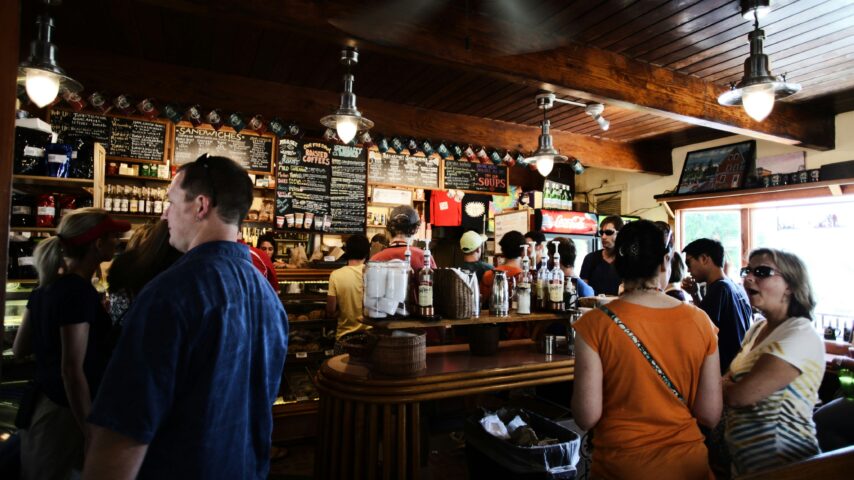In this article
Restaurants and technology have become more and more intertwined over the last ten years. In the seven years since Tenzo was founded, we’ve seen a huge shift from a world where a data strategy wasn’t on anyone’s mind to one where data is central to every business decision.
As we’ve shifted into a much more digitally forward world, hospitality businesses are becoming more efficient and the solutions offered are allowing restaurateurs to focus on hospitality more than ever before.
But there is a ‘but’.
This evolution has meant that restaurants are currently generating more data than ever before and while you would think this would make the restaurateur’s life easier than ever, it’s instead led to new and unique challenges.
The new problem
Seven years ago, Tenzo was dedicated to helping businesses access their data. We lived in a world of limited cloud-based servers, rudimentary APIs and a lack of communal knowledge about data best practices.
Now, the whole industry has shifted and data has become central to running efficient hospitality businesses. The tech has evolved and the amount of data being generated is huge.
However, the problem remains the same – accessing the overwhelming amount of data generated by restaurants is still incredibly difficult. The difficulty means that restaurateurs are still forced to make decisions without seeing the full picture, either with incomplete views of data or by defaulting to gut instinct.
You’re operating in the dark without full data visibility or you have some visibility, but no way to get the insights garnered to the people who can do anything about them in a timely manner. And in an industry where margins are already thin and decisions are constantly being made in the moment, that can mean the difference between success and failure.
Recognising this problem in your business
Many restaurateurs might not know or notice this particular problem because this issue usually manifests itself in different ways. The obvious one is a lack of trust in the reports you generate: different systems and different departments are seeing different figures and drawing different conclusions. This results in siloed decision-making and not working harmoniously.
You might find you’re dealing with huge amounts of unconsolidated reports that need to be manually brought together by a team member, wasting a huge amount of time and also prone to error. This manual process can only be done on a weekly or monthly basis, meaning you’re constantly on the back foot, reactive rather than proactive, and surprised when actual performance doesn’t align with how it felt like you were performing.
There are further consequences though:
- Not optimising staff leaving your team overwhelmed in busy periods and sending people home when it’s not busy.
- Running out of key ingredients or having to throw away spoiled stock.
- Your GMs are frustrated: they can’t meet their targets because they have no visibility day-to-day of how their venues are performing.
- You might have unexpected vendor costs because you’re not tracking weekly inventory cost changes.
- Your ops or finance meetings are disorganised; no one has any information in advance and everything comes as a surprise.
- You’re experiencing high staff turnover because they’re not getting the hours they’ve been promised or the support to grow.
- You might have a spray-and-pray approach to a channel strategy because there’s no visibility of what works best or what marketing campaigns are most effective.
- You might experience a disconnect between your head office and on-the-ground teams.
The instinct when this happens
When you’re constantly fighting fires and know you have a lack of visibility or chaotic communication in your business, the instinct is that you need some sort of data strategy to make it better.
What we find many restaurant operators do at this point is start thinking about dashboards where you bring all your data sources together in one place. Someone is then given the project to do just that. In a large business, it might be a special projects manager or an IT lead. In others, it might be the finance or operations team who takes this project on.
The problem whoever owns this project then encounters is that they’re trying to solve every little detail without taking a step back to look at the bigger picture. They get into the trenches of trying to get every single data source into a singular dashboard, turning to traditional data visualisation tools like PowerBI and Tableau while not thinking about exactly what they want to get out of these dashboards, who will need to access them, and what changes they can make based on the information provided.
Then when inevitably they can’t find a product that works with every single data source they have in their business, they get stuck. This is due to a fundamental lack of understanding of what the project is trying to achieve as well as the technical difficulty of data aggregation. Most people expect a plug-and-play solution to their problem and this is extremely difficult.
Why a simple ‘we need a dashboard’ is actually not so simple
First and foremost, Tenzo wants to make getting access to data a simple and easy task. We pride ourselves on the simplicity of our product. However, what is going on under the surface is no simple task.
When you’re looking at a data strategy – the simple dashboard in this case – there are actually 4 pieces you need to think about.
- How you’re going to aggregate all your data sources together
- How you’re going to visualise this data (the dashboard)
- How you’ll use your insights for future decisions
- How you’re going to communicate the insights from the dashboard across your business
The consequences of not thinking about these 4 separate elements
What happens if you don’t aggregate your data
It’s very difficult to bring your data together automatically, that simple fact means that most restaurateurs are still aggregating data manually.
But when this is done manually, you run into a world of problems.
1. It takes time
Pulling together simple reports can take hours because, for every new data set, the same prolonged process has to take place. The amount of time it takes to build the reports means that by the time the reports are finalised, they’re already out of date. Real-time reports can’t even be a possibility.
If you rush it though, data entry mistakes are made which immediately renders the insights moot leading to dozens of varying versions of reports floating around. No one knows what’s correct and what’s not inherently instilling a lack of trust in the data by the team.
2. You’re limited by your data sources
If you’re only able to pull the static, basic reports provided by your POS or labour scheduler, then you don’t have access to the granular level of data to gain truly helpful insights. With multiple locations to report on, the amount of CSV files to download and compile can be entirely overwhelming, meaning it just doesn’t get done as often as it should.
3. Once you figure out a system that works, you’re constrained by it
If you are able to consolidate data in an automated fashion, it likely took a lot of development time and money to get you there. But the moment something goes wrong, you have to wait for the problem to be identified and then solved. The sunk cost and effort also mean switching your tools is a very laborious, expensive and time-consuming process.
Where analysis meets paralysis
The next thing to consider is what kind of analysis you need across your business. Often we find that the difficulty of aggregating the data means that the reports produced are not fit for purpose.
Businesses may think they need one dashboard for everyone, but what happens, in reality, is that these reports end up being too high-level, generic and static for any one team to make any decisions from. The result is decisions made based on an incomplete picture or resorting to gut instinct.
Really every function and every GM should have dashboards with reports tailored to them, updated in as close to real-time as possible so they can actually use the insights to help operate on a day-to-day basis. But this is impossible to do if you can’t solve the aggregate problem first.
You know what happened yesterday, what about tomorrow?
Setting up dashboards and reports on past performance should be the answer to figuring out what the future will look like. However, in the volatile world of restaurants, this is rarely the case. A real shame because so many elements of operations – staffing, ordering, prepping – need to have a view of the future to be successful.
Just looking at historic performance doesn’t work because hospitality is affected by so many external factors. Demand can depend on the season, on the weather, on holiday schedules, and on local events. And historical data doesn’t take these factors into account.
Because of this, teams might forecast based on gut and wildly over or underestimate the amount of resources they need. Alternatively, they’ll make decisions based on the annual budgets put in place by head office and end up over-resourcing because these budgets tend to be stretch targets. Or they’ll simply use a four-week average and get thrown off by strange weather or a holiday.
Getting the right insight to the right person at the right time
The final hurdle if all of the above is accomplished is disseminating the information to the people who can make the right changes.
What we’ve found is depending on the way insights are distributed, different issues arise.
1. The data visualisation tool
When reports and dashboards are built in traditional data visualisation tools like Power BI, Looker and Tableau, the teams on the ground are unlikely to engage with them. Firstly, they are not mobile-friendly so a GM would need to be at a computer to review – something that takes them away from doing what they do best: providing hospitality and running the restaurant.
These tools also tend to overcomplicate the issue – extremely detailed and granular reports may be good for head office but are not helpful when a GM just wants to know how they’re doing against their targets so far this week.
This stops the people who can actually effect change from engaging with the data that will get them there.
2. The spreadsheet process
The vast majority of operators go the spreadsheet route because it’s what everyone knows and it’s free. But the challenges start cropping up immediately. First, you have to rely on your GMs to input data – a manual and time-consuming process that takes them away from what they do best: providing hospitality. Then, as mentioned, human error can have a serious impact on the trustworthiness of the data: multiple versions of the same sheet start to get circulated and no one knows which is the most up-to-date.
But simply engaging with spreadsheets regardless of the cleanliness of the data is a challenge. Again spreadsheets do not look good on a phone and by the time it’s sent to GMs, there’s not usually much they can do to make any meaningful impact on the outcome.
At the head office level, the number of emails needing to be sent out and the replies can quickly become overwhelming. If you add in needing qualitative data from every location on top of the quantitative, then a 10-location business is looking at dozens of emails every week. Not an ideal situation for the people who need to wade through them, again putting a barrier to entry to using data on a daily basis to make decisions.
Tenzo’s point of view
Ultimately, we have a fundamental belief at Tenzo: empowering frontline workers, not just head office, with data improves restaurant performance.
It’s that belief that dictates how we build Tenzo. Making sure the people who have the ability to effect change in the business are able to do so with the data to back them up is our priority.
As such, we bring the most operationally relevant data into Tenzo, allow any user to visualise it in the simplest way, use it to predict what the future looks like and send the insights to the right people to stop issues in their tracks.
A singular platform for all of your operational data with personalised dashboards based on the metrics most important to the specific user, one reporting language the whole team can rally behind, and the context around budgets to understand how you are impacting the business.
Check back in for our next piece about how we go about solving the technical problems of data in the hospitality industry.
Find out more!
Going on your own data journey? Speak to one of our experts, we can help explain your options and what might work best for your business.





